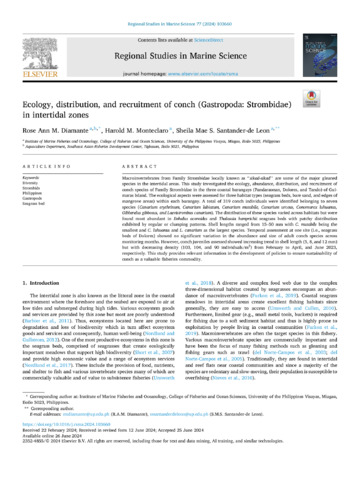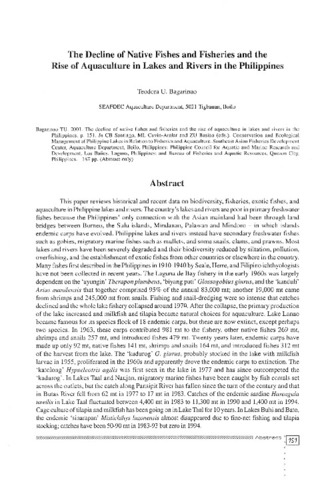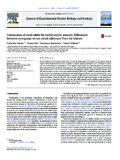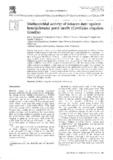Ecology, distribution, and recruitment of conch (Gastropoda: Strombidae) in intertidal zones
Share
Abstract
Macroinvertebrates from Family Strombidae locally known as "sikad-sikad" are some of the major gleaned species in the intertidal areas. This study investigated the ecology, abundance, distribution, and recruitment of conch species of Family Strombidae in the three coastal barangays (Pandaraonan, Dolores, and Tando) of Guimaras Island. The ecological aspects were assessed for three habitat types (seagrass beds, bare sand, and edges of mangrove areas) within each barangay. A total of 319 conch individuals were identified belonging to seven species (Canarium erythrinum, Canarium labiatum, Canarium mutabile, Canarium urceus, Conomurex luhuanus, Gibberelus gibbosus, and Laevistrombus canarium). The distribution of these species varied across habitats but were found most abundant in Enhalus acoroides and Thalassia hemprichii seagrass beds with patchy distribution exhibited by regular or clumping patterns. Shell lengths ranged from 15–50 mm with C. mutabile being the smallest and C. luhuanus and L. canarium as the largest species. Temporal assessment at one site (i.e., seagrass beds of Dolores) showed no significant variation in the abundance and size of adult conch species across monitoring months. However, conch juveniles assessed showed increasing trend in shell length (5, 8, and 12 mm) but with decreasing density (103, 104, and 90 individuals/m2) from February to April, and June 2023, respectively. This study provides relevant information in the development of policies to ensure sustainability of conch as a valuable fisheries commodity.
Suggested Citation
Diamante, R. A., Monteclaro, H., & Santander - de Leon, S. M. (2024). Ecology, distribution, and recruitment of conch (Gastropoda: Strombidae) in intertidal zones. Regional Studies in Marine Science , 77, 103660. https://doi.org/10.1016/j.rsma.2024.103660
Subject
Taxonomic term
Collections
- AQD Journal Articles [1248]
Related items
Showing items related by title, author, creator and subject.
-
The decline of native fishes and fisheries and the rise of aquaculture in lakes and rivers in the Philippines
Bagarinao, Teodora (Aquaculture Department, Southeast Asian Fisheries Development Center; Philippine Council for Aquatic and Marine Research and Development (PCAMRD), Department of Science and Technology; Bureau of Fisheries and Aquatic Resources, 2001)This paper reviews historical and recent data on biodiversity, fisheries, exotic fishes, and aquaculture in Philippine lakes and rivers. The country's lakes and rivers are poor in primary freshwater fishes because the ... -
Colonization of coral rubble by motile cryptic animals: Differences between contiguous versus raised substrates from the bottom
Takada, Yoshitake; Abe, Osamu; Hashimoto, Kazumasa; Shibuno, Takuro (Elsevier, 2016)Recent studies have demonstrated that interstices of coral rubble harbor rich and diverse assemblages of motile cryptic animals. Habitats of coral rubble are prone to frequent physical disturbances, so colonization is an ... -
Molluscicidal activity of tobacco dust against brackishwater pond snails (Cerithidea cingulata Gmelin)
Borlongan, Ilda G.; Coloso, Relicardo M.; Mosura, Edwin F.; Sagisi, Francisca D.; Mosura, Angela T. (Elsevier, 1998)Toxicity tests on the effect of tobacco dust against brackishwater pond snails (Cerithidea cingulata Gmelin) of various stages or size ranges were conducted under controlled laboratory conditions. The 72-h LC50 ...




